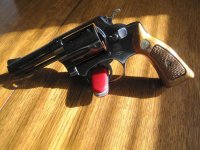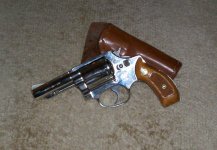Lew Archer
Member
...in my new Model 36-1.
Longer barrel equals longer sight radius. Longer barrel means, maybe, more velocity, less unburned powder, perhaps better internal, external and terminal ballistic performance. Longer barrel means more weight out front...maybe better for balance, recoil management.
So the wisdom goes.
Of course, longer barrel means it's a bit more difficult to conceal, depending on the method used. More weight means somewhat less comfort, when carried all day.
I dropped by one of my local gunshops, Greta's Guns,in Simi Valley, California, on Friday. Greta is the owner's dog, by the way. The owner, a retired LAPD copper, runs a very nice shop.
I was not in the market for anything. Well then...what did I see but a very new looking Model 36, square butt, blue steel, fixed sights with a pinned three inch barrel. Its serial number puts production between 1976 and 1977, as does its Bangor Punta blue box.
The gun looks very lightly used. If the seller had cleaned it, it would appear almost NIB. Faint turn line and that's about it for visible wear. The wood grips, correct for this model and its vintage, looked brand new. The box had some damage, but included paperwork was like new. Clearly, no one read the manual!
Bore looked very clean. No wear to the finish at the muzzle, just a little on the thumb piece (cylinder release latch). Gently testing the action, I decided it was an awfully nice little J frame. In addition to the box, the seller was including an old half empty box of Western ammo...mid range wadcutters. According to the salesman, the owner fired half a box worth and called it a day.
Asking price was $650. I offered $600. A truly new in the box gun should be $650, plus an extra $20 for the three inch barrel, according to the latest blue book values. A 98 percent gun should fetch $535, plus $20 for that three inch barrel.
Ok, we're in California and used guns go for a bit more than blue book here, given some of the limitations...private party transfer only of guns not currently on the California DOJ roster of guns approved for sale in California.
So, I offered $600, splitting the difference, more or less, between 98 percent and 100 percent. I figured I'd offer a price where the seller would get pretty close to his asking price. The reduced price would off set the usual fees, taxes and such a little.
The salesman called the seller, who immediately accepted and I bought the gun. Now, for the 10 day wait.
I've often thought it might be interesting to compare a three inch Model 36 to its 2 inch (well, 1 7/8 inch, really) counterparts. Plus, any fancier of Smiths needs only a hint of a rationalization to add to the accumulation, er, collection.
I hardly NEED another J frame: I've got a like new Model 40 (blue steel frame Centennial with grip safety); a very clean flat latch, blue steel Model 36, stocked with the original grips (with that "diamond" around the grip screw escutcheon): a factory refinished and tuned Model 49, stocked with Spegel boot grips ; a first generation Model 642, stocked with Hogue Bantam grips (it came with Uncle Mikes grips that had finger grooves and covered the backstrap, a bit bulky for such a gun, though I've got them somewhere); a recent production, "no lock" 442, stocked with linen micarta VZ grips; a Model 60, stocked with Pachmayr compact grips; and a four inch Model 63, stocked with Pachmayr grips, complete with finger grooves. With the exception of the .22 caliber 63, all are .38 special and all have the 1 7/8 inch barrel. The 442, 642 and 49 were all purchased new. The rest were acquired used.
So, this new gun fills a clearly much needed niche in the J frame collection! That's my story and I am sticking to it!
It seems like a really handy little revolver. I'm curious if that extra barrel length really makes it significantly easier to shoot. The J frames are wonderful guns, but tough to master. One day, this might make a viable self defense gun for my daughter (she's only 8 now!). I bought that Model 63 to eventually teach her to shoot a revolver. The three inch 36 might make a good defensive gun for her, when the time comes, depending on her interest, with similar feel and manual of arms to the Model 63, if she doesn't fancy a semi-auto by then.
I will post pictures once I get this new gem home...I look forward to hearing anyone's experience with the three inch J frames!
Longer barrel equals longer sight radius. Longer barrel means, maybe, more velocity, less unburned powder, perhaps better internal, external and terminal ballistic performance. Longer barrel means more weight out front...maybe better for balance, recoil management.
So the wisdom goes.
Of course, longer barrel means it's a bit more difficult to conceal, depending on the method used. More weight means somewhat less comfort, when carried all day.
I dropped by one of my local gunshops, Greta's Guns,in Simi Valley, California, on Friday. Greta is the owner's dog, by the way. The owner, a retired LAPD copper, runs a very nice shop.
I was not in the market for anything. Well then...what did I see but a very new looking Model 36, square butt, blue steel, fixed sights with a pinned three inch barrel. Its serial number puts production between 1976 and 1977, as does its Bangor Punta blue box.
The gun looks very lightly used. If the seller had cleaned it, it would appear almost NIB. Faint turn line and that's about it for visible wear. The wood grips, correct for this model and its vintage, looked brand new. The box had some damage, but included paperwork was like new. Clearly, no one read the manual!
Bore looked very clean. No wear to the finish at the muzzle, just a little on the thumb piece (cylinder release latch). Gently testing the action, I decided it was an awfully nice little J frame. In addition to the box, the seller was including an old half empty box of Western ammo...mid range wadcutters. According to the salesman, the owner fired half a box worth and called it a day.
Asking price was $650. I offered $600. A truly new in the box gun should be $650, plus an extra $20 for the three inch barrel, according to the latest blue book values. A 98 percent gun should fetch $535, plus $20 for that three inch barrel.
Ok, we're in California and used guns go for a bit more than blue book here, given some of the limitations...private party transfer only of guns not currently on the California DOJ roster of guns approved for sale in California.
So, I offered $600, splitting the difference, more or less, between 98 percent and 100 percent. I figured I'd offer a price where the seller would get pretty close to his asking price. The reduced price would off set the usual fees, taxes and such a little.
The salesman called the seller, who immediately accepted and I bought the gun. Now, for the 10 day wait.
I've often thought it might be interesting to compare a three inch Model 36 to its 2 inch (well, 1 7/8 inch, really) counterparts. Plus, any fancier of Smiths needs only a hint of a rationalization to add to the accumulation, er, collection.
I hardly NEED another J frame: I've got a like new Model 40 (blue steel frame Centennial with grip safety); a very clean flat latch, blue steel Model 36, stocked with the original grips (with that "diamond" around the grip screw escutcheon): a factory refinished and tuned Model 49, stocked with Spegel boot grips ; a first generation Model 642, stocked with Hogue Bantam grips (it came with Uncle Mikes grips that had finger grooves and covered the backstrap, a bit bulky for such a gun, though I've got them somewhere); a recent production, "no lock" 442, stocked with linen micarta VZ grips; a Model 60, stocked with Pachmayr compact grips; and a four inch Model 63, stocked with Pachmayr grips, complete with finger grooves. With the exception of the .22 caliber 63, all are .38 special and all have the 1 7/8 inch barrel. The 442, 642 and 49 were all purchased new. The rest were acquired used.
So, this new gun fills a clearly much needed niche in the J frame collection! That's my story and I am sticking to it!
It seems like a really handy little revolver. I'm curious if that extra barrel length really makes it significantly easier to shoot. The J frames are wonderful guns, but tough to master. One day, this might make a viable self defense gun for my daughter (she's only 8 now!). I bought that Model 63 to eventually teach her to shoot a revolver. The three inch 36 might make a good defensive gun for her, when the time comes, depending on her interest, with similar feel and manual of arms to the Model 63, if she doesn't fancy a semi-auto by then.
I will post pictures once I get this new gem home...I look forward to hearing anyone's experience with the three inch J frames!
Last edited:





